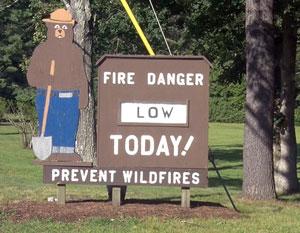Volunteer Fire Department Assistance
DEM Division of Forest Environment (DFE) works closely with volunteer fire departments to mitigate wildfires, provide training and offers a variety of specific programs and services to assist volunteer fire departments.
Click below for more information:

Fire weather updates are posted daily on DFE’s Wildland Fire Control facebook page, during spring fire season, and weekly for the remainder of the year, unless conditions require more frequent posting.
RESOURCES


The DFE Forest Fire Program offers indoor, and hands-on, wildland fire training to VFDs and will accommodate your department’s schedule to deliver effective training, tailored to your department’s needs. We also work closely with the Northeast Forest Fire Protection Compact (NFFPC) to train firefighters with National Wildfire Coordinating Group (NWCG) qualifications.
Our Wildland Fire Attack training is an instructor-led, 2-3 hour classroom training on wildland fire safety, behavior and suppression tactics.
Additional topics include:
- Basic Chainsaw Safety
- Portable Pump and Water Handling
Need other topics or training? Let us know what you are looking for and we will work with you to accomplish your department’s wildfire training goals!
Scheduled trainings, or other shared opportunities, will be posted on DFE's Wildland Fire Control facebook page
For more information on national, or local, wildland fire training, contact Training Officer Ben Arnold at ben.arnold@dem.ri.gov.
After a wildland fire has been brought under control, the Volunter Fire Department must submit a Wildland Fire and Hose Report at Rhode Island Fire Incident Report & Hose Request.
This report is also required as part of the Fire Hose Program in order to get forestry hose exchanged. NOTE: This report form must be completed regardless whether DFE forestry hose was used on the fire or not.
Today DFE maintains 35 miles of 1½" percolating forestry hose on fire department apparatus. This hose in combination with the hose bag and use of the reverse progressive hose lay allows for safe yet rapid intervention on even moderately aggressive fire behavior. The Division of Forest Environment replaces, tests, services and maintains inventory for hose every time it is deployed.
History of the Program
Starting in the mid-1940s, local committees and fire leagues were faced with frequent large fires and struggled to deal with them, including seeking funding for the purchase of fire hose. In 1956, the Director of the Department of Agriculture and Conservation, John Rego, appointed the first Forest Fire Equipment Committee to determine the equipment needs for the Division and to help equip local forest fire services. In 1957, due to recommendations from this group and the newly created Forest Fire Management Group, special permission was obtained from Governor Dennis J. Roberts to reallocate unutilized funds for fire suppression. These funds were used to purchase 20,000 feet of linen, 1½" forestry line with quarter turn couplings, and the Fire Hose Loan program was born.

Rapid Deployment bag (300’ of 1.5” forestry hose) as issued to fire departments, including hose clamp, leader and low volume nozzle
In Rhode Island, local fire departments have the responsibility and authority for all initial attack and extended operations. The hose program allows the departments to have a rapid and highly effective intervention for keeping most fires to a minimum size. Utilizing the reverse progressive hose lay method a crew of 2 can initiate an extremely effective flanking attack by bringing the capabilities of large tankers (tenders) to even the most remote of locations.
Watch our video about the hose loan program:
coming soon
Hose exchange and replacement requests must be submitted through the Rhode Island Fire Incident Report & Hose Request. This is the only way to ensure your request has been received by DFE. Hose will be delivered as soon as possible after receiving the completed form. (Do not contact DEM Enforcement Dispatch regarding fire hose needs.)
For more information about the Fire Hose Loan Program, contact Forest Fire Program Coordinator, Patrick MacMeekin at patrick.macmeekin@dem.ri.gov
Fire-fighting requires water, but some rural and suburban areas do not have a network of water mains and hydrants for fire-fighting. Where water mains do occur, providing drinking water, the quantity of water in these systems may not be able to support the greater flows needed for fire suppression. But many residents may expect a similar level of service as in more urban areas, even though they may pay lower taxes. Dry hydrants are a way for rural communities, and volunteer fire departments, to provide an improved network for water supplies critical for a fire department's success.
As part of the Volunteer Fire Assistance Grant Program, dry hydrants are eligible for match grant funding.
For more information about the Fire Hose Loan Program, contact Forest Fire Program Coordinator, Patrick MacMeekin at patrick.macmeekin@dem.ri.gov.
Safe Ash Disposal
Safe Open Burning
Reverse Progressive Hose Lay
Wildland Fire Tools: Pulaski
Wildland Fire Tools: Bladder Bag

Smokey Bear has been nationally recognized as a Wildfire Prevention Symbol since 1944. His slogan "Only You Can Prevent Wildfires" has been used for over 75 years to help reduce human-caused wildfires. With an increase in rural population density and outdoor recreation activities, Smokey Bear’s message is more important than ever.
DFE maintains a Smokey Bear costume available for use by local fire departments or any groups promoting a fire prevention safety message.
Resources
For more information on the history of Smokey Bear and guidelines for Costume use visit: https://smokeybear.com/en
Use Guideliness for Smokey Bear
To request the Smokey Bear Costume for a wildfire prevention themed event contact Allan Waterman at: allan.waterman@dem.ri.gov

